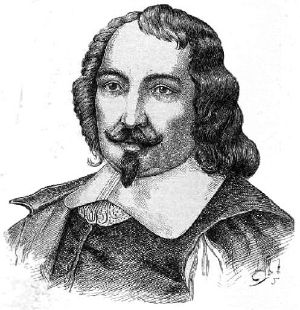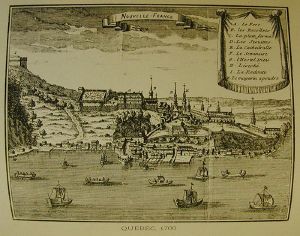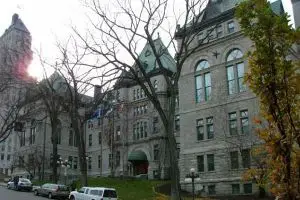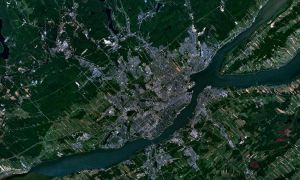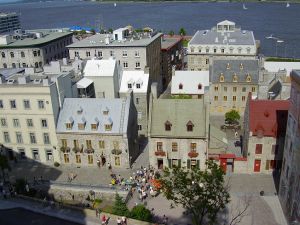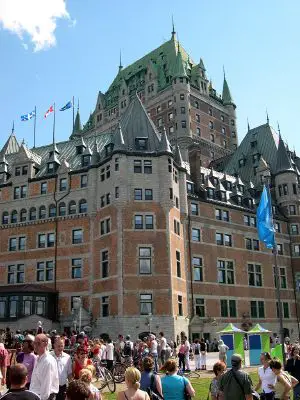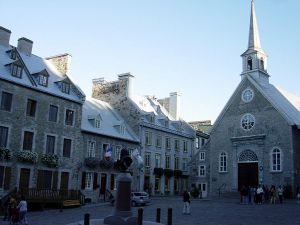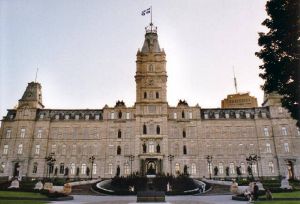Quebec City
| Quebec City, Quebec Ville de Québec, Québec |
|||
|
|||
| Motto: Don de Dieu feray valoir (I shall put God's gift to good use) |
|||
| Site in the province of Quebec | |||
| Coordinates: 46°48′N 71°23′W | |||
|---|---|---|---|
| Country | |||
| Province | Template:QUE | ||
| Agglomeration | Quebec City | ||
| Statute of the city | Capitale-Nationale | ||
| Administrative Region | Capitale-Nationale | ||
| Founded | 1608 by Samuel de Champlain | ||
| Constitution date | 1833 | ||
| Government | |||
| - Mayor | Andrée Boucher | ||
| - Chief of the opposition | Ann Bourget | ||
| - Federal senator | Dennis Dawson | ||
| - MPs | Luc Harvey, Josée Verner, Christiane Gagnon, Michel Guimond, Daniel Petit, Sylvie Boucher | ||
| - MNAs | Hubert Benoit, Philippe Couillard, Jean-François Gosselin, Sam Hamad, Éric Caire, Sylvain Légaré, Agnès Maltais, Catherine Morissette, Gilles Taillon | ||
| Area | |||
| - City | 542.71 km² (209.5 sq mi) | ||
| Population (2006, 2001*, 2005**) | |||
| - City | 491,142 (Ranked 10th) | ||
| - Metro | 717,600* | ||
| - Région de Québec | 1,064,047** | ||
| Time zone | Eastern (UTC-5) | ||
| Area code(s) | 418 | ||
| Geographical code | 24 23027 | ||
| Website: Official website of Quebec City | |||
Quebec City or Québec (French: Ville de Québec, or simply Québec) is the capital of the Canadian province of Quebec. It is the second largest city in the province, after Montreal. Quebec's Old Town (Vieux-Québec), the only North American fortified city north of Mexico whose walls still exist, was declared a World Heritage Site by the United Nations Educational, Scientific and Cultural Organization (UNESCO) in 1985 as the "Historic District of Old Quebec". It is also one of the oldest cities in North America. The city has a population of 528,595, and the metropolitan area has a population of 717,600 (2005).
Quebec City is known for its Winter Carnival and the Château Frontenac, a historic hotel which dominates the city skyline. The National Assembly of Quebec (provincial parliament), the Musée national des beaux-arts du Québec (National Museum of Fine Arts) and the Museum of Civilization are found within or near Vieux-Québec.
Among the tourist attractions in the city are Montmorency Falls and the Basilica of Sainte-Anne-de-Beaupré in the town of Beaupré.
History
Etymology
The narrow width of the river as it enters the towns of Quebec and Lévis, on the opposite bank, provided the name given to the city, Kébec being the Algonquin word meaning "where the river narrows".
Early history: from Stadacona to Seven Years War
Quebec City is one of the oldest settlements in North America. While many of the major cities in Mexico date from the sixteenth century, among cities in the U.S. and Canada only St. John's, Newfoundland and Labrador, Port Royal, Nova Scotia, St. Augustine, Florida, Santa Fe, New Mexico, and Tadoussac, Quebec were created earlier than Quebec. However Quebec city is the first to have been founded with the explicit goal of receiving permanent settlement, and not as a commercial outpost, and therefore is considered to be the first European-built city in non-Spanish North America.
Quebec was founded by Samuel de Champlain on 3 July 1608 at the site of a long abandoned St. Lawrence Iroquoian settlement called Stadacona. It was to this settlement that the name "Canada" refers. It is the cradle of the Francophone population in North America. The place seemed favourable to the establishment of a permanent colony.
Before Champlain, French explorer Jacques Cartier built a fort at the site in 1535, where he stayed for the winter before going back to France in spring 1536. He came back in 1541 with the goal of building a permanent settlement. This first settlement was abandoned less than one year after its foundation, in the summer 1542, due in large part to the hostility of the natives combined with the harsh living conditions during winter.
At the end of French rule in 1763, the territory of present-day Quebec City was a world of contrasts. Forests, villages, fields and pastures surrounded the town of 8 000 inhabitants. The town distinguished itself by its monumental architecture, fortifications, muddy and filthy streets, affluent homes of masonry and shacks in the suburbs St-Jean and St-Roch. Despite its urbanity and its status as capital, Quebec City remained a small colonial city with close ties to its rural surroundings. Nearby inhabitants traded their farm surpluses and firewood for imported goods from France at the two city markets.
Quebec City was captured by the British in 1759 and held until 1763. It was the site of the Battle of the Plains of Abraham during the Seven Years' War, in which British troops under General James Wolfe defeated the French general Louis-Joseph de Montcalm and took the city. France later ceded New France to Britain.
British rule
During the American Revolution, revolutionary troops from the southern colonies assaulted the British garrison in a futile attempt to liberate Quebec City now known as the Battle of Quebec. The defeat of the revolutionaries from the south put an end to the hopes that the peoples of Quebec would rise and join the Revolution. Major General Isaac Brock fortified Quebec City by strengthening the walls and building an elevated artillery battery before the War of 1812.
In 1840, after the Province of Canada was formed, the capital was shared between Kingston, Montreal, Toronto, Ottawa and Quebec City (from 1852 to 1856 and from 1859 to 1866). In 1867, Ottawa (which was chosen to be the permanent capital of the Province of Canada) was chosen to be the capital of the Dominion of Canada. The Quebec Conference on Canadian Confederation was held here.
20th and 21st centuries
In World War II, two conferences were held in Quebec City. The first one was held in 1943 with Franklin Delano Roosevelt (the United States' president), Winston Churchill (the United Kingdom's prime minister), William Lyon Mackenzie King (Canada's prime minister) and T.V. Soong (China's minister of foreign affairs). The second one was held in 1944, and was attended by Churchill and Roosevelt. They took place in the buildings of the Citadelle and of nearby Château Frontenac. A large part of the D-Day Landings plans were made during those meetings.
Capital
Throughout its nearly four hundred years of existence, Quebec City has served as a capital:
- from 1608 to 1627 and 1632 to 1763, it was capital of French Canada and all of New France,
- from 1763 to 1791, it was the capital of the Province of Quebec,
- from 1791 to 1841, it was the capital of the Province of Lower Canada,
- from 1852 to 1856 and from 1859 to 1866, it was capital of the Province of Canada,
- from 1867 to today, it has been capital of the Province of Quebec.
It is also the principal city of the Agglomeration of Quebec City, the Greater Quebec City Area, the administrative region of Capitale-Nationale, and the Quebec City Area.
French/English nomenclature
The city is called Québec (with an acute accent) by both the provincial and federal governments in both languages. To differentiate between Quebec the city and Quebec the province in English, the city is commonly referred to as "Quebec City" while the province is referred to as "Quebec". It is common for the accent to be dropped in English texts.
In French, Quebec City is generally referred to simply as "Québec" without the French equivalent of the word "city." French names of large geographical regions such as provinces and countries are typically preceded by articles whereas city names are not (unless it is part of the name, such as "La Malbaie"). As a result, the province is called le Québec ("in Quebec" = au Québec, from Quebec = du Québec) while the city is simply Québec ("in Quebec City" is à Québec, "from Quebec City" = de Québec).
The official legal, corporate name of the city is Ville de Québec in both languages.[1] In the English section of Quebec City's official website, the city is referred to as "Québec City" (with the acute accent over the 'e').
In French, residents of Quebec City are called Québécois (male) or Québécoise (female). To avoid confusion with Québécois/e meaning an inhabitant of the province, the term Québécois/e de Québec for residents of the city is sometimes used (as opposed to Québécois/e du Québec, resident of the province). In English, the term Quebecer (or Quebecker) is sometimes used, but use of the French Québécois or Québécoise is increasingly common.
Also, Quebec City is sometimes referred to as "la capitale nationale" ("the national capital"). The government officially named it this way under the Union Nationale party. Its region bears this name as well. It should be noted, however, that the word national in this sense refers to Quebec as a nation, or distinct group, within the country of Canada, and has no official indication of sovereignty[1].
Municipal public administration
City Council
The mayor of Quebec City is Andrée Boucher, independent, and the chief of the official opposition is Ann Bourget from the Renouveau municipal de Québec.
| Party | Initial | Chief | Governorship | Opposition | Seats |
|---|---|---|---|---|---|
| Renouveau municipal de Québec | R.M.Q. | Ann Bourget | 1989 - 2006 | 2006 - | 24 |
| Action civique de Québec | A.C.Q. | Pierre-Michel Bouchard | 6 | ||
| Parti Vision Québec | V.Q. | Marc Bellemare | 1 | ||
| Option Capitale | O.C. | Pierre Coté | 0 | ||
| Independent | Ind. | 6 | |||
| Vacant | 0 | ||||
| Total | 37 |
The city today
Quebec City has thirty-four districts in eight boroughs.
| Borough | Districts |
| La Cité | Latin/Old Québec · Quartier gai · Saint-Jean-Baptiste · Montcalm · Saint-Sacrement · Petit Champlain · Saint-Sauveur · Saint-Roch · Saint-Malo |
| Les Rivières | Lebourgneuf, Duberger, Les Saules and Vanier |
| Sainte-Foy—Sillery | Cité universitaire · Saint-Louis · Sillery · Pointe-de-Ste-Foy |
| Charlesbourg | Saint-Rodrigue · des Sentiers · des Monts |
| Beauport | Vieux-Moulin · Sainte-Thérèse-de-Lisieux · Villeneuve · Courville |
| Limoilou | Maizerets · Vieux-Limoilou · Lairet · du Colisée |
| La Haute-Saint-Charles | Lac-Saint-Charles, Saint-Émile, Neufchâtel and Loretteville |
| Laurentien | Val-Bélair, Cap-Rouge |
| *These neighbourhoods are not legally separate. | |
The Lower Town is filled with original architecture and street designs, dating back to the city's beginnings. Murals and statues are also featured. The Lower Town is also noted for its wide variety of boutiques, many featuring hand-crafted goods.
Demographics
According to the last (May 2001) census, there were 682,757 people residing in Quebec City, of whom 48.2% were male and 51.8% were female. Children under five accounted for approximately 4.7% of the resident population of Quebec City. This compares with 5.2% in the province of Quebec, and 5.6% for Canada overall.
While Montreal is considered by many to be a bilingual city, with many of its residents having a working knowledge of both French and English, Quebec City and its surrounding region is largely Francophone. The large majority of city residents are native French-speakers.
In mid-2001, 13.0% of the resident population in Quebec City was of retirement age (65 and over for males and females) compared with 13.2% in Canada. The average age is 39.5 years of age compared to 37.6 years of age for Canada as a whole.
In the five years between 1996 and 2001, the population of Quebec City grew by 1.6%, compared with an increase of 1.4% for the province of Quebec as a whole. Population density of Quebec City averaged 216.4 people per square kilometre, compared with an average of 5.3, for the province of Quebec as a whole.
At the time of that May 2001 census, the population of the Quebec City authority was 682,757, but was 710,700 when encompassing the Greater Quebec City Area, compared with a resident population in the province of Quebec of 7,237,479 people.
According to the 2001 census, over 90% of the population was Roman Catholic, along with small Jewish and Protestant populations.
| 1931 | 1941 | 1951 | 1961 | 1971 | 1981 | 1991 | 2001 | 2006 |
|---|---|---|---|---|---|---|---|---|
| 131 000 | 151 000 | 289 000 | 379 000 | 481 000 | 576 000 | 646 000 | 683 000 | 720 000 |
Transportation
Quebec City is served by Jean Lesage International Airport, located in the West of the city. [2]
The city also has a large major port on the St-Lawrence in the first, fifth and sixth boroughs. Web site
Three bridges, the Quebec Bridge and Pierre Laporte Bridge connect the city with the south shore of the Saint Lawrence River, as does a ferry service to Lévis, and Orleans Island Bridge connects Quebec City with the Orleans Island. The city is a major hub in the Quebec provincial road network, fanning out from both sides of the river with an extensive autoroute system.
Several important motorways of the Quebec road network pass by Quebec City, of which Autoroute 40 connects it towards the west to Montreal and Route 175 connects it towards the north to Chicoutimi.
Three principal expressways cross the agglomeration from the north to the south (starting from the west): Autoroute Henri-IV, Autoroute Robert-Bourassa , and Autoroute Laurentienne. Three other motorways cross the western part of town (from north to south): Autoroute Félix Leclerc (known by the inhabitants as "Autoroute de la Capitale"), Autoroute Charest, as well as Champlain Boulevard, which goes along the river to the Downtown area, then another Autoroute called Dufferin-Montmorency allows easier access to the extreme east of the city.
The city is served by VIA Rail (Gare du Palais), and is the eastern terminus of the railway's main Quebec City-Windsor Corridor. The bus station, with connections to the provincial long-distance bus network, is also in the same location.
The Réseau de transport de la Capitale is responsible for public transportation by bus. Web site in French only
An overdependence on autos leaves little room for cyclists on the roads. They are generally forced into autos as in most American cities, detracting from the European character of the city.
Public safety
Quebec City is protected by Service de police de la Ville de Québec and Service de protection contre les incendies de Québec.
Attractions
Many of the city's attractions are east of the fortification walls in Vieux-Québec (Old Quebec). This area has a distinct European feel unique in North America with its stone buildings and winding streets lined with shops and restaurants. Porte St-Louis (St. Louis Gate) and Porte St-Jean (St. Jean Gate) are the main gates through the walls from the modern section of downtown. West of the walls are the Colline-Parlementaire (Parliament Hill) district and the Plaines d'Abraham (Plains of Abraham).
Quebec City's skyline is dominated by the massive Château Frontenac Hotel, perched on top of Cap-Diamant. The hotel is beside the Terrasse Dufferin (Dufferin Terrace), a walkway along the edge of the cliff, offering beautiful views of the Saint Lawrence River.
Near the Château Frontenac is Notre-Dame de Québec Cathedral, mother church of the Roman Catholic Archdiocese of Quebec. It is the first church in the New World to be raised to a basilica and is the primatial church of Canada.
The Terrasse Dufferin leads toward the nearby Plains of Abraham, site of the battle in which the British took Quebec from France, and the Citadelle of Quebec, a Canadian Forces installation and the federal vice-regal secondary residence. The National Assembly, Quebec's provincial legislature, is also near the Citadelle.
The Haute-Ville (Upper Town) is linked by the Escalier «casse-cou» (literally "neck-breaker" steps) and the Old Quebec Funicular to the Basse-Ville (Lower Town), which includes such sites as the ancient Notre Dame des Victoires church, the historic Petit Champlain district, the port, and the Musée de la Civilisation (Museum of Civilization). Université Laval is located in the western end of the city, in the borough of Sainte-Foy. However, the school of architecture of Université Laval is located in Old Quebec. The central campus of the Université du Québec is also located in Quebec City. Canon balls are placed beside "Château Frontenac."
Quebec City is known for its Winter Carnival and for its Saint-Jean-Baptiste Day celebrations.
Tourist attractions located near Quebec City include Montmorency Falls and the Basilica of Sainte-Anne-de-Beaupré.
Museums
- Musée national des beaux-arts du Québec
- Musée de la civilisation
- Musée de l'Amérique française
- Espace Félix Leclerc
- Musée naval de Québec
- Choco-Musée Erico
- Musée des Ursulines de Québec
- Musée du Royal 22e Régiment/La Citadelle de Quebéc
- Musée Québec Expérience
- Musée de l'Abeille
- Plains of Abraham Exhibition Center
Festivals and events
Contest
- Concours de musique du Canada (Le) Web site in French only was established in Quebec and caters to young Canadian musicians under 25 (under 30 for singers) aspiring to compete at the international level in various disciplines.
Autumn (September & October)
- Envol et macadam Web site in French only is both a contest and a festival of alternative music held annually in September. It is devoted to the latest musical trends (Punk, Hip-hop, Techno, Rock'n'Roll) and features indoor and outdoor shows.
- Fête du quartier Saint-Sauveur is celebrated annually in September in the First District.
- Festival des journées d'Afrique, Danses et Rythmes du monde Web site in French only is held September, featuring African and Latin American shows.
- Fête Arc-en-ciel Web site in French only is a gay and lesbian festival held in September.
- Quebec City Celtic Festival Web site is a celebration of Scottish, Irish and Breton roots including shows, workshops and conferences. It is held in early September.
- Journées de la Culture (Les) Web site offers free cultural events in September
- Québec Ateliers Ouverts Web site in French only, held every two years in September. Professional artists and craftsmen open their workshops to the general public to showcase their works and techniques.
Winter (November to March)
- Carnaval de Québec (Le) Website is the biggest winter carnival in the world, held over two weeks in February.
- Coup de cœur Francophone (Le) Web site in French only is a festival of Francophone music held in November each year in 8 Canadian cities. In Quebec City, the event is held over 10 days in small venues.
- Festival des musiques sacrées de Québec (Le) Web site in French only is held in November and features sacred music from various nations and time periods.
- Parade des jouets (La) Web site in French only is an interactive parade of mascots and floats held in November by city firefighters to collect toys and gifts for local underprivileged children.
- Mois Multi (Le) Web site in French only features electronic and multidisciplinary art expositions, held annually in February.
- Québec Celebrates Christmas Web site is held in December and January, features activities and exhibits throughout Quebec City.
Spring (April & May)
- Festival de cinéma des 3 Amériques (Le) Web site in French only is held over 5 days in March/April featuring independent films from the Americas.
- Carrefour international de théâtre de Québec (even years) and the Théâtres d'ailleurs Festival (odd years) Web site are held in May or June.
- Festival de la gastronomie du Québec - Coupe des Nations (Le) Web site in French only, held in April, features competitions in culinary arts and wine making.
- Salon International du Livre de Québec (Le) Web site in French only takes place in April and features French literature and comic strips from Québec.
Summer (June to August)
- Birthday Of Quebec City Web site give place to family festivals of district in the districts of the city on July 3 of each year. Major demonstrations will take place all the summer 2008 for the 400th birthday of foundation of the city.
- Fetes de la Nouvelle France is a celebration in early August held in remembrance of the early French colonial times.
- Plein art is an arts/crafts exhibition.
- Fete Internationale de Musiques Militaires is a celebration of military music which is held in late August.
First borough (La Cité)
- Grand Rire (Le) Web site in French only is a festival of humour, who takes place over 10 days in June. Spectacles in sport and official receptions in room introduce humorists of Quebec city and elsewhere, beginners or confirmed.
- Fête nationale des Québécois et des Québécoises is celebrated by various activities including one large outside spectacle in the evening of June 23 on the Plains of Abraham.
- Fête du Canada (La) Web site is celebrated to it June 30th and July 1st at various locations in Old-Quebec, by spectacles and activities and free admission to the national historic sites of the city.
- Festival d'été de Québec (Le) Web site is a major event which annually presents during two weeks in July a great number of musical spectacles (popular, French-speaking person and English-speaking, music of the world, classical music) for the majority in sport and of many services in arts of the street at various places in the old capital as well as interior spectacles in various rooms of the capital.
- Fête du Faubourg (La) is a street fair which takes place in the Saint-Jean-Baptist district in the first borough (La Cité) on a weekend beginning July, annually.
- Fêtes de la Nouvelle-France (Les) Web site is a major event which presents during one week in August various activities allowing of relivig the 17th century, the time of Nouvelle France, in Old Quebec and the Royal Place (processions, spectacles, animations, demonstrations of the everyday life of the time, market in sport of Nouvelle-France, dressed up observers and citizens, etc.).
Natural science sites
- Jardin zoologique du Québec, reopened in 2002 after two years of restorations but closed in 2006 after a political decision. It was presenting to the public 750 specimens of 300 different species. The zoo was specialized in winged fauna and garden themes, but also presented several species of mammals. While it emphasizes the indigenous fauna of Quebec, one of its principal attractions was the Indo-Australian greenhouse, featuring fauna and flora from these areas.
- Parc Aquarium du Quebec, reopened in 2002 on a site overlooking the St. Lawrence River, presents more than 10,000 specimens of mammals, reptiles, fish and other aquatic fauna of North America and the Arctic. Polar bears and various species of seals of the Arctic sector and the "Large Ocean", a large basin offering visitors a view from underneath, form part of the principal attractions. Website : http://www.spsnq.qc.ca/
Post-secondary education
|
University level
|
College level
|
ReferencesISBN links support NWE through referral fees
- ↑ House passes motion recognizing Québécois as nation. CBC.ca. Retrieved 2007-03-24.
External links
- Tourist information of the Quebec city area Retrieved June 25, 2007.
- Official website of Quebec City Retrieved June 25, 2007.
- Official website of Quebec City Tourism Retrieved June 25, 2007.
- Quebec City Guide - Télégraphe de Québec Retrieved June 25, 2007.
- Quebec City on Google Maps Retrieved June 25, 2007.
- Buildings of Quebec City Retrieved June 25, 2007.
- Quebec 2008 (400th Anniversary) Retrieved June 25, 2007.
- Parc technologique du Québec métropolitain (French) Retrieved June 25, 2007.
- Municipal election in Quebec City - Radio-Canada.ca (French) Retrieved June 25, 2007.
- Quebec politics (French) Retrieved June 25, 2007.
- Website of the firemen of Quebec City (French) Retrieved June 25, 2007.
- Quebec's Old Town Photo Tour Retrieved June 25, 2007.
- Quebec City Pictures Retrieved June 25, 2007.
Credits
New World Encyclopedia writers and editors rewrote and completed the Wikipedia article in accordance with New World Encyclopedia standards. This article abides by terms of the Creative Commons CC-by-sa 3.0 License (CC-by-sa), which may be used and disseminated with proper attribution. Credit is due under the terms of this license that can reference both the New World Encyclopedia contributors and the selfless volunteer contributors of the Wikimedia Foundation. To cite this article click here for a list of acceptable citing formats.The history of earlier contributions by wikipedians is accessible to researchers here:
The history of this article since it was imported to New World Encyclopedia:
Note: Some restrictions may apply to use of individual images which are separately licensed.

